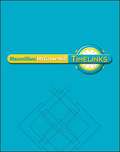 United States: History
1351753
United States: History
1351753
|
James A. Banks
Kevin P. Colleary
Linda Greenow
|
9780021458462 |
2014 |
NIMAC restricted
Contains images
|
|
 Glencoe Health
1333408
Glencoe Health
1333408
|
Mary H. Bronson
|
9780021459681 |
2015 |
NIMAC restricted
Contains images
|
|
 Matemáticas: Edición basada en los estándares comunes, CCSS, Curso 1, Volumen 2 (Math Applic And Conn Crse Ser.)
2470934
Matemáticas: Edición basada en los estándares comunes, CCSS, Curso 1, Volumen 2 (Math Applic And Conn Crse Ser.)
2470934
|
Day
Carter
Cuevas
|
9780021459988 |
2015 |
NIMAC restricted
Contains images
|
|
 Indiana The United States, Early Years [Grade 5]
183380
Indiana The United States, Early Years [Grade 5]
183380
|
Dinah Zike
James A. Banks
Kevin P. Colleary
Linda Greenow
Walter C. Parker
Emily M. Schell
|
9780021512553 |
2010 |
NIMAC restricted
Contains images
|
|
 The United States: Early Years
259160
The United States: Early Years
259160
|
Dinah Zike
James A. Banks
Kevin P. Colleary
Linda Greenow
Walter C. Parker
Emily M. Schell
|
9780021512560 |
2010 |
NIMAC restricted
Contains images
|
|
 Indiana Timelinks: People, Places and Culture in Europe and the Americas [Grade 6]
191969
Indiana Timelinks: People, Places and Culture in Europe and the Americas [Grade 6]
191969
|
Dinah Zike
James A. Banks
Kevin P. Colleary
Linda Greenow
Walter C. Parker
Emily M. Schell
|
9780021512577 |
2009 |
NIMAC restricted
Contains images
|
|
 Ohio [Grade 4]
481890
Ohio [Grade 4]
481890
|
James A. Banks
Kevin P. Colleary
Walter C. Parker
|
9780021512737 |
2007 |
NIMAC restricted
Contains images
|
|
 All Together Culture
1097900
All Together Culture
1097900
|
Dinah Zike
James A. Banks
Kevin P. Colleary
Linda Greenow
Walter C. Parker
Emily M. Schell
Irma M. Olmedo
Raymond C. Jones
|
9780021513444 |
2009 |
NIMAC restricted
Contains images
|
|
 People and Places Culture
117217
People and Places Culture
117217
|
Dinah Zike
James A. Banks
Kevin P. Colleary
Linda Greenow
Walter C. Parker
Emily M. Schell
Irma M. Olmedo
Raymond C. Jones
|
9780021513451 |
2009 |
NIMAC restricted
Contains images
|
|
 Communities
191666
Communities
191666
|
Dinah Zike
James A. Banks
Kevin P. Colleary
Linda Greenow
Walter C. Parker
Emily M. Schell
Irma M. Olmedo
Raymond C. Jones
|
9780021513468 |
2009 |
NIMAC restricted
Contains images
|
|
 Our Country and Its Regions, Volume 1 [Grade 4]
130077
Our Country and Its Regions, Volume 1 [Grade 4]
130077
|
Dinah Zike
James A. Banks
Kevin P. Colleary
Linda Greenow
Walter C. Parker
Emily M. Schell
|
9780021513475 |
2009 |
NIMAC restricted
Contains images
|
|
 The United States, Volume 1 [Grade 5]
259162
The United States, Volume 1 [Grade 5]
259162
|
Dinah Zike
James A. Banks
Kevin P. Colleary
Linda Greenow
Walter C. Parker
Emily M. Schell
|
9780021513482 |
2009 |
NIMAC restricted
Contains images
|
|
 The World, Volume 1
300167
The World, Volume 1
300167
|
James A. Banks
Kevin P. Colleary
Linda Greenow
|
9780021513499 |
2009 |
NIMAC restricted
Contains images
|
|
 People and Places Citizenship
117214
People and Places Citizenship
117214
|
Dinah Zike
James A. Banks
Kevin P. Colleary
Linda Greenow
Walter C. Parker
Emily M. Schell
Irma M. Olmedo
Raymond C. Jones
|
9780021513604 |
2009 |
NIMAC restricted
Contains images
|
|
 Ohio The United States: Early Years
482389
Ohio The United States: Early Years
482389
|
James A. Banks
Kevin P. Colleary
Linda Greenow
|
9780021517206 |
2009 |
NIMAC restricted
Contains images
|
|
 The World, Volume 1 [Grade 6] (Ohio Timelinks)
2799567
The World, Volume 1 [Grade 6] (Ohio Timelinks)
2799567
|
Linda Greenow
James Banks
Kevin Colleary
|
9780021517220 |
2009 |
NIMAC restricted
Contains images
|
|
 The World, Volume 2 [Grade 6]
308670
The World, Volume 2 [Grade 6]
308670
|
James A. Banks
Kevin P. Colleary
Linda Greenow
|
9780021517237 |
2009 |
NIMAC restricted
Contains images
|
|
 World Atlas: Grade 3-6
238334
World Atlas: Grade 3-6
238334
|
Macmillan/McGraw-Hill Glencoe
|
9780021517831 |
2009 |
NIMAC restricted
Contains images
|
|
 César Chávez
244986
César Chávez
244986
|
Teri Crawford Jones
|
9780021518753 |
2009 |
NIMAC restricted
Contains images
|
|
 Coretta Scott King
1089283
Coretta Scott King
1089283
|
Teri Crawford Jones
|
9780021519033 |
2009 |
NIMAC restricted
Contains images
|
|
 César Chávez Fighting for Farm Workers
249117
César Chávez Fighting for Farm Workers
249117
|
Judith Lechner
|
9780021520046 |
2009 |
NIMAC restricted
Contains images
|
|
 Liliuokalani The Last Queen of Hawaii
254487
Liliuokalani The Last Queen of Hawaii
254487
|
Katacha Díaz
|
9780021520077 |
2009 |
NIMAC restricted
Contains images
|
|
 The Amish
244988
The Amish
244988
|
Judith Lechner
|
9780021520138 |
2009 |
NIMAC restricted
Contains images
|
|
 The Navajo Tradition and Change
249118
The Navajo Tradition and Change
249118
|
Josie Black
|
9780021520169 |
2009 |
NIMAC restricted
Contains images
|
|
 Mark Twain
251246
Mark Twain
251246
|
Claire Daniel
|
9780021520190 |
2009 |
NIMAC restricted
Contains images
|
|